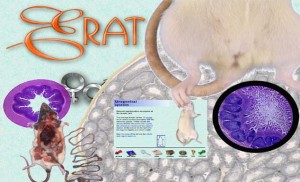With the advancement of technology and computer software, several alternatives to dissections have been introduced to schools.
A Wide Range of Options:
- E-Rat, Cyberfrog, and other Dissection Simulator Software: Companies such as Science Works and Tangent Scientific have taken advantage of the computer software boom and have create programs that allow students to learn anatomy and function through audiovisual activities, online quizzes, and dissection simualtions (Fleischmann, 2003; Predavec, 2001). These programs allow students to view structures from a wide range of individuals, both male and female through all life stages, work at their own pace, review a dissection multiple times, and test their learning. http://www.biolsci.monash.edu.au/undergrad/erat/index.html
- 3D Models, Diagrams, and Charts: Useful for displaying structures, models have also been used in veterinarian colleges to replace dog abdomens and skeletal structures (Balcombe, 2001).
- Plants, Fungi, and Owl Pellets: These can all be dissected to learn about biology without harming animals.
- Observational Studies: Viewing animals in their natural habitats can provide better understanding of behavior and lifestyles.
- Ethical Dissection: Using animals that have died of natural causes for dissection can be a better option than raising and killing animals specifically for science. Animals could be obtained from local farms, animal shelters, or wildlife rehabilitation centers.
Effectiveness of Alternatives
In a study using E-Rat as an alternative to conventional dissection with first year university students, Predavec (2001) evaluated student learning in multiple choice exams and found that students using E-Rat scored better on average than those performing a dissection. Overall, students who studied with the alternative were better able to associate structures with their names and functions (Predavec, 2001). In a similar study using a videodisc simulation of frog simulation on high school biology students, it was found that the interactive computer program was just as effective in teaching the learning objectives as was conventional dissection (Strauss and Kinsie, 1994). In the interactive simulated frog dissection, students responded more positively in the areas of time efficiency, attention levels, understanding of results, following instructions, and general learning satisfaction (Strauss and Kinsie, 1994).
A comprehensive review of these types of experiments by Balcombe (2001) shows consistency in the result that there is no different in student learning between animal dissections and computer based alternatives. Many times, undergraduate biology students fare better academically when taught with alternatives (Balcombe, 2001).

